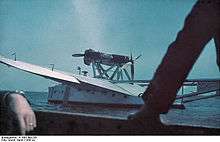Savoia-Marchetti S.55
| Savoia-Marchetti S.55 | |
|---|---|
 | |
| An S.55P of Aeroflot circa 1933 | |
| Role | Flying boat |
| Manufacturer | Savoia-Marchetti |
| Designer | Alessandro Marchetti |
| First flight | August 1924 |
| Introduction | 1926 |
| Retired | 1945 |
| Primary users | Società Idrovolanti Alto Italia (Savoia) Regia Aeronautica |
| Number built | 243+ |
| Variants | Savoia-Marchetti S.66 |
The Savoia-Marchetti S.55 was a double-hulled flying boat produced in Italy, beginning in 1924. Shortly after its introduction, it began setting records for speed, payload, altitude and range.
Design and development
The S.55 featured many innovative design features. All the passengers or cargo were placed in the twin hulls, but the pilot and crew captained the plane from a cockpit in the thicker section of the wing, between the two hulls. The S.55 had two inline counter-rotating propellers, achieved by mounting the twin engines back to back. The engines were canted sharply at an upward angle. Two wire-braced booms connected the triple-finned tail structure to the twin hulls and wing.
Operational history

Even though its design was unusual, the Savoia-Marchetti S.55 was a remarkably airworthy craft. In 1926, the S.55P prototype set 14 world records for speed, altitude and distance with a payload.[1] The S.55's greatest successes, however, were its many flights between Europe and the Americas.
The first staged south Atlantic Ocean crossing was made in 1922 using three different Fairey III machines and the Dornier Do J Plus Ultra crossed in January 1926 with a single stop at the Cape Verde Islands.
The first S.55 crossing was made a year later by the Santa Maria under Francesco de Pinedo. After flying south to Bolama, at that time in Portuguese Guinea they hoped to cross the ocean without another stop but were forced down at Cape Verde, reaching Brazil on 23 February 1927. After the crossing, the aircraft was traded to Brazil for coffee beans.
The Brazilian João Ribeiro de Barros and his crew of three made another crossing in S.55 "Jahú" on 24 April 1927. Departing from Santiago Island, he crossed the Atlantic in "Jahú" and landed at Fernando de Noronha Island, Brazil.
Pilots Francesco de Pinedo and Carlo del Prete took off from Sesto Calende, Italy, in an S-55. Four months later, they arrived back in Italy, having flown nearly 48,280 km (30,000 mi) in 193 flying hours and having made just over 50 stops, including Rio de Janeiro, Buenos Aires and New York City.
On June 20, 1928 Savoia-Marchetti S.55 I-SAAT Santa Maria, piloted by Ten. Col. Umberto Maddalena of the Italian air force, located survivors of Arctic explorer Umberto Nobile's crashed airship Italia on an ice floe about 120 km (75 mi) northeast of Nordaustlandet, Svalbard.
The Italian Air Marshall of the time, Italo Balbo became famous for organizing a squadron of S.55s for Atlantic crossings, culminating in his 1933 flight with 24 aircraft to Chicago's Century of Progress International Exposition. On 1 July 1933, General Balbo commanded a flight of S-55s from Orbetello, Italy, completing the flight in just over 48 hours, maintaining a tight "V" formation. These large fleets of aircraft were sometimes called a "Balbo".
The aircraft went on to serve in the Regia Aeronautica as a long-range bomber and patrol aircraft, but by World War II, the last S.55s were no longer serviceable and were in reserve.
Surviving aircraft
The last remaining example is preserved in Brazil, at the TAM "Asas de um sonho" museum, at São Carlos, São Paulo. The aircraft, registered I-BAUQ and named "Jahú", was the S.55 used by Commander João Ribeiro de Barros in his crossing of the South Atlantic in 1927.[2]
Variants
- S.55
- Prototypes and original production model delivered from 1927 to 1930, 90 built, including two prototypes.
- S.55C
- Civil variant delivered from 1925 to 1926, eight built.

- S.55P
- Improved civil variant with enlarged hull for ten passengers and enclosed cockpits delivered from 1928 to 1932, 23 built.
- S.55A
- Military variant delivered with 418 kW (560 hp) Fiat A.22R engines, 16 built.
- S.55M
- Variant with some wood structures replaced by metal, seven built by Piaggio in 1930.
- S.55 Scafo Allargato
- Widened and deepened hull and enclosed cockpits, 16 built by Savoia-Marchetti and 16 built by CANT.
- S.55 Scafo Allargatissimo
- Variant with greatly enlarged hull, 20 built by Savoia-Marchetti, 16 built by Macchi and six built by CANT.
- S.55X
- Variant fitted with Isotta-Fraschini Asso 750 engines for North Atlantic formation flights, later armed and used as a reconnaissance-bomber. 25 built.
Operators
Civil operators
- Marine Air Transport Co.
Military operators
- Brazilian Navy (8 airplanes)
-
.svg.png) Spain (1937)
Spain (1937)
- Royal Romanian Air Force (7 airplanes 1933–1943)
Specifications (S.55X)
General characteristics
- Crew: five-six
- Length: 16.75 m (55 ft 0 in)
- Wingspan: 24.00 m (74 ft 9 in)
- Height: 5.00 m (16 ft 5 in)
- Wing area: 93.0 m² (1,001 ft²)
- Empty: 5,750 kg (12,677 lb)
- Loaded: kg ( lb)
- Maximum takeoff: 8,260 kg (18,210 lb)
- Powerplant: 2x Isotta-Fraschini Asso 750V, 656 kW (880 hp) each
Performance
- Maximum speed: 279 km/h (173 mph)
- Range: 3,500 km (2,200 mi)
- Service ceiling: 5,000 m (16,405 ft)
- Rate of climb: m/min ( ft/min)
- Wing loading: kg/m² ( lb/ft²)
- Power/Mass: kW/kg ( hp/lb)
Armament
- 4 x 7.7 mm (.303 in) machine guns
- 1 x torpedo or
- 2,000 kg (4,409 lb) of bombs
See also
- Related lists
References
- Notes
- Bibliography
- Yenne, Bill. Seaplanes & Flying Boats: A Timeless Collection from Aviation's Golden Age. New York: BCL Press, 2003. ISBN 1-932302-03-4.
External links
| Wikimedia Commons has media related to Savoia-Marchetti S.55. |